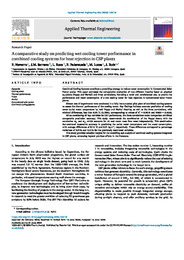Por favor, use este identificador para citar o enlazar este ítem:
https://hdl.handle.net/11000/35399Registro completo de metadatos
| Campo DC | Valor | Lengua/Idioma |
|---|---|---|
| dc.contributor.author | Navarro Cobacho, Pedro | - |
| dc.contributor.author | Serrano Rodríguez, Juan Miguel | - |
| dc.contributor.author | Roca, Lidia | - |
| dc.contributor.author | Palenzuela, Patricia | - |
| dc.contributor.author | Lucas Miralles, Manuel | - |
| dc.contributor.author | Ruiz Ramírez, Javier | - |
| dc.contributor.other | Departamentos de la UMH::Ingeniería Mecánica y Energía | es_ES |
| dc.date.accessioned | 2025-01-28T13:43:23Z | - |
| dc.date.available | 2025-01-28T13:43:23Z | - |
| dc.date.created | 2024 | - |
| dc.identifier.citation | Applied Thermal Engineering | es_ES |
| dc.identifier.issn | 1873-5606 | - |
| dc.identifier.issn | 1359-4311 | - |
| dc.identifier.uri | https://hdl.handle.net/11000/35399 | - |
| dc.description.abstract | Combined Cooling Systems constitute a promising strategy to reduce water consumption in Concentrated Solar Power plants. This paper addresses the comparative evaluation of two different theories based on physical equations (Poppe and Merkel) and three correlations, including a novel and unreferenced one, to predict the performance and water consumption of a wet cooling tower for heat rejection in Concentrated Solar Power plants. Sixteen sets of experiments were conducted in a fully instrumented pilot plant of combined cooling systems to assess the thermal performance of the cooling tower. Key findings indicate accurate prediction of cooling tower outlet water temperature by both Poppe and Merkel theories, as well as the three correlations, with minimal differences, less than 0.94 °C (2.78%), corresponding to values of R = 0.9918 and RMSE = 0.4650. When considering all key variables for CSP performance, the three correlations under comparison exhibited comparable prediction accuracy. This study recommends the combination of the Poppe theory with the correlation and , which accounts for air and water mass flow rates independently. This combination demonstrated reasonable accuracy in predicting the outlet water temperature and the water consumption, with average differences of 0.14 °C and 0.01 kg s−1, respectively. These differences correspond to percentage variations of 0.91% and 9.21% for the previously mentioned variables. This study provides valuable insights for the modelling and analysis of combined cooling systems integrated in CSP plants, advancing beyond previous efforts in the literature. | es_ES |
| dc.format | application/pdf | es_ES |
| dc.format.extent | 14 | es_ES |
| dc.language.iso | eng | es_ES |
| dc.publisher | Elsevier | es_ES |
| dc.relation.ispartofseries | 253 | es_ES |
| dc.rights | info:eu-repo/semantics/openAccess | es_ES |
| dc.rights | Attribution-NonCommercial-NoDerivatives 4.0 Internacional | * |
| dc.rights.uri | http://creativecommons.org/licenses/by-nc-nd/4.0/ | * |
| dc.subject | Cooling tower | es_ES |
| dc.subject | Thermal performance | es_ES |
| dc.subject | Poppe | es_ES |
| dc.subject | Merkel | es_ES |
| dc.subject | Concentrated solar power | es_ES |
| dc.subject | Combined cooling systems | es_ES |
| dc.subject.other | CDU::6 - Ciencias aplicadas::62 - Ingeniería. Tecnología::621 - Ingeniería mecánica en general. Tecnología nuclear. Electrotecnia. Maquinaria | es_ES |
| dc.title | A comparative study on predicting wet cooling tower performance in combined cooling systems for heat rejection in CSP plants | es_ES |
| dc.type | info:eu-repo/semantics/article | es_ES |
| dc.relation.publisherversion | https://doi.org/10.1016/j.applthermaleng.2024.123718 | es_ES |

Ver/Abrir:
2024 ATE 253.pdf
2,54 MB
Adobe PDF
Compartir:
 La licencia se describe como: Atribución-NonComercial-NoDerivada 4.0 Internacional.
La licencia se describe como: Atribución-NonComercial-NoDerivada 4.0 Internacional.
.png)